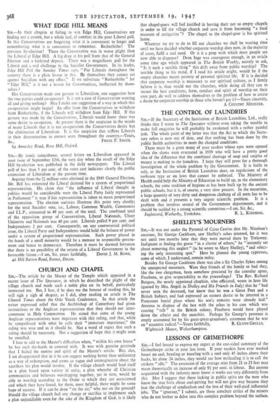SHELLEY'S 'MOURNERS
Sia,—It was not under the Pyramid of Cahn Cestius that Mr. Nicolson's ancestor, Sir George Cockburn, saw Shelley's ashes interred, for it was not until two months later that they were moved there by Trelawny. Indignant at finding the grave "in a cluster of others," he "instantly set about removing this neglect" (as he wrote to Mary Shelley), "and select- ing the only interesting spot." Here he planted the 'young cypresses, some of which, I understand, remain today.
Besides Sir George Cockburn there was also a Sir Charles Sykes among the unexpected mourners. Were they friends of the family or had they, like the two clergymen, been somehow procured by the consular agent, Freeborn, to give respectability to the proceedings? The Rev. Richard Burgess, the newly appointed chaplain, who officiated, wrote in later life (quoted by Mrs. Angeli in Shelley and His Friends in Italy) that he "had never seen the deceased, but knew that he was a Great Poet and a British Subject, and had expressed an earnest desire to be interred in a Protestant burial place where his son's remains were already laid." Anxious to dispose of the box with the ashes in his care which was causing " talk " in the British colony, Freeborn would have played down the atheist and the anarchist. Perhaps Sir George's presence is amply accounted for by his great-great-grandson's statement that he was
an "eccentric radical."—Yours faithfully, R. GLYNN GRYLLS. Wightwick Manor, Wolverhampton.


































 Previous page
Previous page